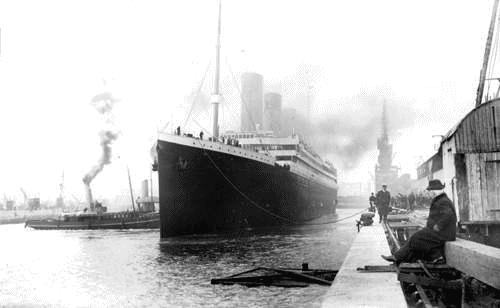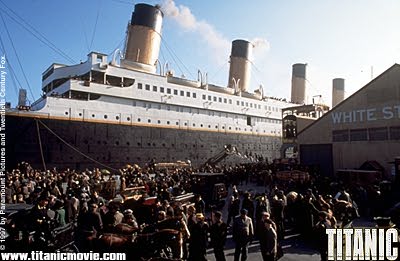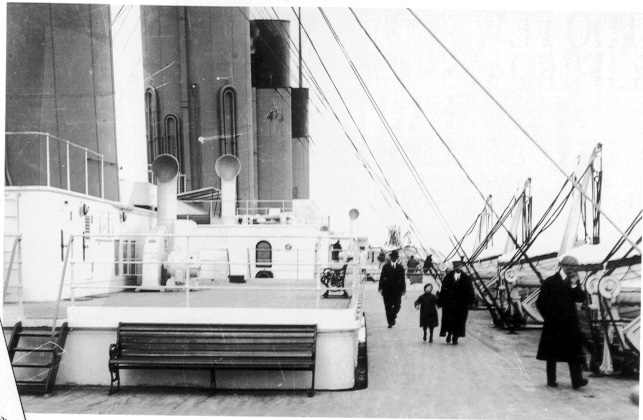[an error occurred while processing this directive]The maiden voyage of Titanic was almost canceled due to the coal strike, and thus many ships of White Star's parent company, the International Mercantile Marine, were laid up, and passengers like Benjamin Hart with his wife Esther and daughter Eva, originally sailing on other ships transferred to Titanic. When Benjamin told his family of the news of being bumped from Philadelphia to the unsinkable Titanic, his wife Esther was far from happy. "To call a ship unsinkable is flying in the face of God." she said, fearfully. At Southampton, there was a brief reshuffling of officers. Not to mention a whole lot of last minute preparations, delays due to the Olympic's recent accidents. So busy, that the usual press tour of White Star ships was canceled. By April 10th, everything was ready. Well, almost. The binoculars were missing. During the reshuffle, the crew seemed to have misplaced them. On board were the Who's who of 1912.
 There were
passengers like millionaire John Jacob Astor with his wife Madeline, steel magnate
Benjamin Guggenheim and his mistress Leontine Aubert, Broadway producer Henry B. Harris
with his wife Renée, another steel magnate Arthur Ryerson with his wife and three
children, railroad owner Charles M. Hays, author/historian/colonel Archibald Gracie,
presidential aide Archibald Butt, the creme de la creme of society. There was also science
teacher Lawrence Beesley, cinematographer Daniel Marvin, and immigrants like Daniel
Buckley and Karen Abelseth. Along with them, of course, were Thomas Andrews to take over
for the ill Pirrie and the rest of the Harland and Wolff team, plus White Star director,
J. Bruce Ismay. A few stokers that had stayed in a bar too long were rushing to get on
board. They came to a railroad crossing, and Fireman John Podesta jumped ahead and made it
to the waiting Titanic, leaving the other stokers waiting for the interminably long train
to pass. By then, they were too late, and a junior officer, perhaps Sixth Officer James
Moody, denied them entrance. At noon, Titanic cast off from the White Star Dock (now Ocean
Dock.) and tugs had begun to take her out to sea. Before long, there were sounds
There were
passengers like millionaire John Jacob Astor with his wife Madeline, steel magnate
Benjamin Guggenheim and his mistress Leontine Aubert, Broadway producer Henry B. Harris
with his wife Renée, another steel magnate Arthur Ryerson with his wife and three
children, railroad owner Charles M. Hays, author/historian/colonel Archibald Gracie,
presidential aide Archibald Butt, the creme de la creme of society. There was also science
teacher Lawrence Beesley, cinematographer Daniel Marvin, and immigrants like Daniel
Buckley and Karen Abelseth. Along with them, of course, were Thomas Andrews to take over
for the ill Pirrie and the rest of the Harland and Wolff team, plus White Star director,
J. Bruce Ismay. A few stokers that had stayed in a bar too long were rushing to get on
board. They came to a railroad crossing, and Fireman John Podesta jumped ahead and made it
to the waiting Titanic, leaving the other stokers waiting for the interminably long train
to pass. By then, they were too late, and a junior officer, perhaps Sixth Officer James
Moody, denied them entrance. At noon, Titanic cast off from the White Star Dock (now Ocean
Dock.) and tugs had begun to take her out to sea. Before long, there were sounds  that likened to a gun firing. This
was the mooring ropes of the American Line's New York snapping, and the ship was turning
towards the Titanic. the stern of the New York was drawing perpendicular to Titanic's hull
and the bowsprit of the New York had brushed the nearby White Star steamer, Oceanic. At
the last moment, the tugboat Vulcan came and pushed the New York out of the way. An ill
omen on a maiden voyage, many said. The Vulcan had saved Titanic for a fate worse than
just a few bent plates. Titanic cruised passed the Solent, where the H.M.S. Hawke had
rammed the Olympic almost a year before. Mrs. Marconi, wife of the famed inventor of the
radio, watched sadly as the Titanic glided by. Her husband Guglielmo had crossed
previously on the Cunarder Lusitania, and She hoped to join him in America after crossing
on the Titanic. However, her daughter became ill and she had to stay behind. Her daughter
watched Mrs. Marconi sigh as Titanic passed by, and knew how much she wanted to be
onboard. The delay at Southampton had pushed back Titanic's schedule a bit, and wasn't
able to dock at Cherbourg, France until 9 that night. Passenger Frank Carlson was not able
to get onboard. His car had broken down in the middle of the road, and he missed the ship.
The next morning at 10, the Titanic reached Queenstown, (now Cobh.) Ireland, and there
another omen occurred. A stoker, black with soot, appeared on top of the dummy funnel
number 4, which many likened the apparition to an angel of death. When Titanic left
Queenstown later that day, she was one crewman short. Stoker John Coffey had crept into a
mailbag and jumped ship. At the beginning of the voyage, a few ice warnings poured in from
La Provance and Taurenfels. (sp?) Smith decided to take a more southerly route. The first
few days of the voyage passed uneventfully, almost boring had it not been for the
amenities that were aboard Titanic. There was talk that the ship was out to get the Blue
Riband of the North Atlantic, a title for the North Atlantic's fastest ship.
that likened to a gun firing. This
was the mooring ropes of the American Line's New York snapping, and the ship was turning
towards the Titanic. the stern of the New York was drawing perpendicular to Titanic's hull
and the bowsprit of the New York had brushed the nearby White Star steamer, Oceanic. At
the last moment, the tugboat Vulcan came and pushed the New York out of the way. An ill
omen on a maiden voyage, many said. The Vulcan had saved Titanic for a fate worse than
just a few bent plates. Titanic cruised passed the Solent, where the H.M.S. Hawke had
rammed the Olympic almost a year before. Mrs. Marconi, wife of the famed inventor of the
radio, watched sadly as the Titanic glided by. Her husband Guglielmo had crossed
previously on the Cunarder Lusitania, and She hoped to join him in America after crossing
on the Titanic. However, her daughter became ill and she had to stay behind. Her daughter
watched Mrs. Marconi sigh as Titanic passed by, and knew how much she wanted to be
onboard. The delay at Southampton had pushed back Titanic's schedule a bit, and wasn't
able to dock at Cherbourg, France until 9 that night. Passenger Frank Carlson was not able
to get onboard. His car had broken down in the middle of the road, and he missed the ship.
The next morning at 10, the Titanic reached Queenstown, (now Cobh.) Ireland, and there
another omen occurred. A stoker, black with soot, appeared on top of the dummy funnel
number 4, which many likened the apparition to an angel of death. When Titanic left
Queenstown later that day, she was one crewman short. Stoker John Coffey had crept into a
mailbag and jumped ship. At the beginning of the voyage, a few ice warnings poured in from
La Provance and Taurenfels. (sp?) Smith decided to take a more southerly route. The first
few days of the voyage passed uneventfully, almost boring had it not been for the
amenities that were aboard Titanic. There was talk that the ship was out to get the Blue
Riband of the North Atlantic, a title for the North Atlantic's fastest ship.  That
was just talk. Although Ismay wanted to impress people with what Titanic could do,
grabbing the Blue Riband from Cunard's Mauretania wasn't one of the ways he planned to do
so. After all, Titanic was designed for luxury, not speed. Titanic's top speed was only
24.5 knots, still no match for the Mauretania's 28 capability. Rumor had it he wanted to
beat the Olympic's speed record, but it would not be possible due to the lack of coal from
the strike. However, passengers like Elizabeth Lines and Marian Thayer had heard Ismay say
that he planned to be in New York on Tuesday the 16th instead of Wednesday the 17th and
surprise everyone. However, Captian Smith wanted to make sure that Titanic did not arrive
in New York earlier than 5 in the morning on Wednesday the 17th. The speed run would be
restricted to Monday. The winter of 1912 had been rather warm, causing more icebergs
calving off glaciers, and a massive ice field lay in the path of Titanic. On the night of
Saturday, April 13, Eva Hart remembered being woken up by her mother after there was a
brief shuddering of the ship. Esther woke up Benjamin too and proceeded to go up when they
were told it was nothing. Titanic was like an icebreaker. That Sunday, 14 April, ten ice
warnings were received, but only five were posted on the bridge. The messages that were
posted were from Caronia, La Touraine, the first from Californian, Baltic (which Ismay
showed off to everyone.) , Noordam (which Captain Smith never showed anyone.), and a morse
signal from the Rappahanock. There were others, from Amerika, another from Frankfurt. The
most important one from the Mesaba, talking about an ice field that Titanic was already
in, and another from the Californian, which the Titanic told to shut up. Neither of those
reports ever reached the bridge.
That
was just talk. Although Ismay wanted to impress people with what Titanic could do,
grabbing the Blue Riband from Cunard's Mauretania wasn't one of the ways he planned to do
so. After all, Titanic was designed for luxury, not speed. Titanic's top speed was only
24.5 knots, still no match for the Mauretania's 28 capability. Rumor had it he wanted to
beat the Olympic's speed record, but it would not be possible due to the lack of coal from
the strike. However, passengers like Elizabeth Lines and Marian Thayer had heard Ismay say
that he planned to be in New York on Tuesday the 16th instead of Wednesday the 17th and
surprise everyone. However, Captian Smith wanted to make sure that Titanic did not arrive
in New York earlier than 5 in the morning on Wednesday the 17th. The speed run would be
restricted to Monday. The winter of 1912 had been rather warm, causing more icebergs
calving off glaciers, and a massive ice field lay in the path of Titanic. On the night of
Saturday, April 13, Eva Hart remembered being woken up by her mother after there was a
brief shuddering of the ship. Esther woke up Benjamin too and proceeded to go up when they
were told it was nothing. Titanic was like an icebreaker. That Sunday, 14 April, ten ice
warnings were received, but only five were posted on the bridge. The messages that were
posted were from Caronia, La Touraine, the first from Californian, Baltic (which Ismay
showed off to everyone.) , Noordam (which Captain Smith never showed anyone.), and a morse
signal from the Rappahanock. There were others, from Amerika, another from Frankfurt. The
most important one from the Mesaba, talking about an ice field that Titanic was already
in, and another from the Californian, which the Titanic told to shut up. Neither of those
reports ever reached the bridge.